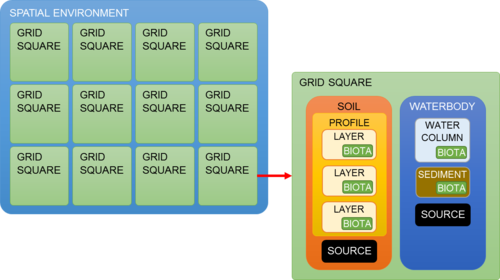WP2
Model development, integration and interoperability for multimedia fate and biouptake assessment
Lead: Stephen Lofts, NERC Centre for Ecology and Hydrology (Lancaster)
This work package is responsible for developing the spatially-explicit modelling frameworks, for predicting nanomaterial fate and biouptake in the environment, that form core outputs of the NanoFASE project. Predicting the fate of nanomaterials for regulatory purposes, such as REACH, requires a relatively simple assessment tool to perform screening evaluations of fate at a range of scales from local upwards. Predicting how nanomaterials become distributed in soils and surface water, and the identification of "hotspots" in the environment where nanomaterials tend to accumulate, requires a higher-tier dynamic modelling tool with spatially explicit parameterisation and driving data which can predict the movement and transformations of nanomaterials released into the environment.
To do this, we will develop two complementary modelling systems. For screening level assessment we will further develop the SimpleBox4Nano model. SimpleBox4Nano is a nanomaterial-specific development of the SimpleBox model, which underpins the EU’s chemical risk and safety decision-support tool EUSES. For the more complex, spatially explicit fate and biouptake assessment, we will develop a coupled soil-water-sediment transport framework with descriptions of nanomaterial transport, transformation and biouptake to create the NanoFASE model. The aim of developing a new, nanomaterial-specific model is to take advantage of state-of-the-art approaches to model structuring, specifically the concept of object–orientation. This allows the physical structure of the environment (including nanoparticle populations) to be represented in code by a structured collection of discrete ‘objects’. It permits an efficient separation of transport and transformation algorithms for nanoparticles. It also allows the definition of a nanoparticle ‘type’, i.e. the set of algorithms that describe the behaviour of a specific group of nanoparticles having common transformation behaviours. New types will be readily added to the model system, and existing types extended, making the NanoFASE model able to be extended to consider types of nanoparticles not yet subject to environmental release.

The specific objectives of WP2 are to:
- Couple models of value chain, managed waste and accidental releases with models of transformation within environmental compartments to provide a spatially-explicit, multimedia, multi-scale exposure assessment tool (the NanoFASE model system), with the flexibility to address stakeholder needs for ENM fate assessment across local to regional scales;
- Upgrade the SimpleBox4Nano (SB4N) model to provide a state-of-the-art tool for screening ENM fate assessment up to continental scale;
- Refine the developed models by application to real-world case studies (WP1) at a range of scales and provide final case study applications to the overall Exposure Assessment Framework (WP1);
- Develop a catalogue of model algorithms and parameterisations (WP4-9) to facilitate their wider incorporation into existing exposure prediction tools and ensure that the method and model developments within NanoFASE have the broadest and highest possible impact.
